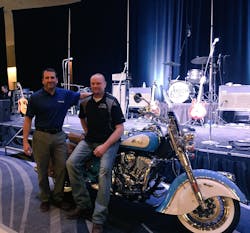K&M Tire Dealers Learn Sales, Customer Service and Efficiency Tips
K&M Tire Inc. founder Ken Langhals likes to remind his 600-plus employees that a customer’s tire order one day doesn’t guarantee another order the next. And that means K&M’s annual dealer conference is an opportunity to provide dealers with help and extra services that set K&M apart from other wholesalers. And as Greg Ring, director of training and development for K&M, put it, as the Delphos, Ohio-based tire distributor continues to grow, Langhals’ rule remains especially important.
K&M is definitely growing, and in 2017 it acquired two other wholesale operations - Becker Tire in Kansas, and MotoStar Tire and Auto Parts Inc. with facilities in New York, New Hampshire and Maine.
Cheryl Gossard, president of K&M, says the Becker Tire deal has helped alleviate pressure and shorten routes from the company’s existing Wichita warehouse to customers throughout rural, western Kansas.
And the MotoStar acquisition has opened up K&M to a brand new territory in the northeastern U.S. It also leaves room for even more expansion as K&M can eventually link the routes and close the gap between New York and its existing warehouse in the Cleveland, Ohio area.
“There’s still a gap there where we can continue to grow.”
The real hallmark of the K&M dealer conference is the series of educational sessions it offers, alongside a trade show with 60 vendors. Here’s a look at three lessons learned during the 2018 conference held in the Chicago suburb of Schaumburg.
Sell the total cost of ownership
Gary Schroeder is director of the global truck and bus tire business for Cooper Tire & Rubber Co. He expects interstate truck stops will become an even bigger player in the marketplace. But that doesn’t mean he thinks they’ll do the best job. “I would suggest you guys can out service a Love’s or TA (Truck Service) all day long.”
One way for commercial tire dealers to improve their competitive edge, especially with fleet customers is to “understand the total cost of ownership and sell it.” Fleets are closely measuring the performance and life of their tires — “to the fourth or fifth decimal point,” Schroeder says.
Create the ultimate customer experience - in 3 steps
Keynote speaker Scott McKain asked dealers to imagine how their businesses compare with the competition. And he stressed nothing - not even tires - has to be a commodity. The difference is in the experience.
McKain says creating a distinctive customer experience boils down to a three-step action plan.
1. Processing: Identify the critical steps in your customer interactions. These are the basics - the non-negotiable things - that you and your team must execute every single time. Identify them, and then do them relentlessly.
2. Service. This is where customer service comes enters the equation. What are you doing to take care of your customer?
3. Experience. This is the point where things get emotional. How are you creating a personal connection and an emotional experience for your customers?
“Execute all three to create a distinctive experience that attracts.
Be as efficient as your coffee station Dennis McCarron, executive director of DSP 20 Group, told dealers that there’s a big difference between doing things faster, and doing them more efficiently. Having a rule that requires technicians to run across the parking lot to pull each vehicle into a bay might save a couple seconds. But what are the risks, and are they worth it?
McCarron asked dealers to picture the spot where their coffee pot is located. The coffee machine is next to the filters which are next to the coffee, which is next to the cups, the creamer and sugar and the stirrers.
Where are all the oil filters kept? Often, McCarron sees technicians walking across five bays to grab a filter. With multiple technicians doing that several times a day, those employees are wasting time, “and time is the new world currency.” It might only be a few seconds, but those seconds add up, and McCarron says tire dealers who have moved supplies closer to where the service occurs are able to do more work each day.
“It can help get one or two more oil changes per day.”
